Mary Ellen Edwards ('MEE') and her family
The eldest surviving daughter of Mary Meadows and Richard Johnson was Mary Johnson, who married Downes Edwards in 1831. Theirs was a happy and prosperous marriage, which mixed and matched Downes Edwards' innovative skills as an engineer and the Meadows gift for art amongst the seven surviving children of a total brood of nine. Whilst the four boys tended to inherit their father's methodical intellectual approach, the three girls were all gifted artists, heavily influenced by their Meadows heritage and particularly by the influence and friendship of their uncle, Edward Killingworth Johnson.
Mary Johnson and Downes Edwards
Mary Johnson, was born in about 1809 in the then hamlet of Kentish Town. On September 17th, 1831, she married Downes Edwards in her parish church, St Mary at Lambeth (depicted below), where her aunt Ann Meadows had married John Massey Wright.

Downes was an engineer born c.1805 in Lambeth, who was living in Brompton at the time of his marriage. His father-in-law, Richard Johnson, had consulted Downes about the provisions in his will for the Johnson children, and so Downes probably naturally slipped into the role of head of the family when Richard Johnson died in 1836. The first census returns for the orphaned Johnsons in 1841 appear to confirm the new centre o family gravity around Downes and Mary Edwards, with Mary’s sister Fanny Johnson living at Elder Cottage in Brixton with Downes’ father, Phillip Edwards, (a banker’s clerk) and his family; and the younger Johnson siblings, Jessica, Emma and Edward Killingworth Johnson, living on a farm in Surbiton, in close proximity to Mary and Downes Edwards.
Downes himself owned a farm on Surbiton Hill, where he lived with his wife and family. In 1840, he took out a patent for an invention which was to make his fortune, and went into business with his brother Henry to create the firm of Edwards Brothers. Downes had discovered a method of preserving potatoes and vegetables, which amounted to tinning vegetables and then transforming them into powdered vegetables which could be reconstituted with water and milk. The contemporary “Dictionary of Arts, Manufacture and Mines', by Andrew Ure, (1858) describes the secret of their success:
"Many methods have at different times been tried for preserving potatoes in an unchangeable state ... but none with such success as the plan of Mr Downes Edwards for which he obtained a patent in August 1840. ... heated by steam into a granular meal. When this is mixed into a pulp with hot water, and seasoned with milk &c, it forms a very agreeable food - like fresh mashed potatoes." The brothers soon became one of the most reputable grocer’s suppliers, with their products later exhibited in the Crystal Palace Food Gallery in the early 1850s.
Downes and Mary Edwards began their married life somewhere in or around Kensington, before moving to Surbiton, and then to Greenwich from about 1842-1847. By 1848, the family had moved once again, but this time much further, to Douglas on the Isle of Man. In the 1851 census, Downes gave his profession as “potatoes preserver patentee, employing 16 men and 24 women’. In 1853 he took out another patent, this time for improvements to railway signalling, and in 1859 and 1862 further patents were granted for new inventions to pump improvements. Downes clearly flourished when he was in the Isle of Man, enough to be able to construct his own residence, Ravenscliffe, which merited a mention in a later tourist guide and is considered today one of the finest Victorian houses on the island.
By the end of the 1850s, Downes, Mary and their family had returned to London. Fortune continued to smile upon Downes Edwards, and the 1860 Court Guide records the family residence as 28, Upper Belgrave Place, Pimlico. This entry may suggest that Downes, a man whose ingenuity embodied the spirit of the age, had been presented at court. In the 1861 census, Downes was recorded as an “engineer and copper land maine (?)”, living at 17 Brompton Crescent in fashionable South Kensington. The family later moved to South Parade close to St Luke’s Church in Chelsea. Downes Edwards died in 1882 in Hove, and is buried in the grounds of St Andrew's Church. Mary Edwards stayed in Hove with her two spinster daughters, and is recorded in the 1891 census living in Osborne Villas. Mary Edwards died in Hove in 1898, and the Edwards and Johnson families retained strong links to Hove up until at least the beginning of the 20th century.
The children of Mary Johnson and Downes Edwards
Downes and Mary had nine children. Two children died in infancy, and only appear in the 1841 census: Fanny Edwards born c.1836, and Phillip Charles Edwards c.1840-1843, named after his Edwards grandfather. A mourning portrait of the infant Philip, from the family collection of his uncle Edward Killingworth Johnson, is reproduced below by kind permission of Julian Scott.

Their eldest surving child, Richard Downes Edwards was born on the 23rd July, 1833. He was recorded as a pupil for a year at King William's College on the Isle of Man in 1847-48, before following his father’s example as an engineer and inventor. On December 30th, 1858, Richard Downes Edwards of Upper Belgrave Place took out a patent with John Knowleden of Southwark, for an "improvement for hydraulic engines and apparatus connected therewith". Knowleden came from a modest family of marine engineers and "patent improvers" of steam boilers in Southwark and Limehouse, but the connection between Rich Richard and Poor John is not immediately obvious. On August 11th, 1863, Richard Downes Edwards of 1, Bishopsgate Street in the City of London (close to the former Broad Street professional address of his grandfather, Richard Johnson), took out another patent for an "improvement for the method of cleansing and treating cotton seed." Richard seems to have thus inherited his father's ability to turn his talents to varying industrial, and potentially lucrative, needs. In later life, Richard changed course for more literary pursuits, first as an advertising agent and then a journalist. In the 1881 census he lived at 32 Elm Park Road in Chelsea with his wife Marie (a British subject born in France), two younger brothers, and two servants from Sible Hedingham. Richard Downes Edwards died in Hove in 1885, and is buried in the same grave as his father.
William Douglas Edwards (c.1848-1932) was born in Douglas on the Isle of Man, and became a barrister at Lincolns Inn in London and quite naturally the legal advisor to his family. Edward Walter Edwards was born in c.1850 in Douglas. In 1871 he was the clerk to a solicitor but by the time of his marriage in 1874, he had become an accountant. Edward married Ellen Scott Lancefield, the daughter of the Scottish surveyor and civil engineer Alfred Lancefield, at St Luke's Church, Chelsea, where the witnesses were his sister Mary Ellen Edwards and his aunt Fanny Johnson. His wife had apparently already been accepted into the family, as she gave her address as Sible Hedingham, presumably in the household of either Mary Ellen or Fanny. The couple moved to Clapham, and by the end of the 1870s they had two daughters, Fanny Eveline Edwards and Mary Ellen Edwards. The Benjamin of the Edwards tribe, Downes Ernest Edwards (c.1852-1939), was also born in Douglas. In 1871 he was recorded as a ‘student of music’ living with his parents, and in 1881 he was a journalist, living with his eldest brother Richard. By 1891, he was an advertising manager for a newspaper, living by the Strand in London, and later retired to Cricklewood and then Ealing. His sister, Mary Ellen Edwards, lived with him at the end of their lives.
The three Edwards girls all inherited the Meadows gift for art. Mary Ellen Edwards was born in 1838 in Surbiton, and her career is described in detail below. Catherine Julia Edwards (c.1842-1924) was probably born in in Greenwich. Kate Edwards, as she was known, is one of the 'forgotten' artists of the Meadows family. Nonetheless, in the 'Dictionary of British Book Illustrators and Artists' by Simon Houfe, she is described as an "outstanding artist". Kate made her reputation working alongside her sister Mary Ellen Edwards on the literary magazines, 'London Society', and 'Once a week' from the mid-1860s. Three examples of her work demonstrating her talent as a figure artist can be viewed on the links below.
Kate Edwards, 'The June Dream', 1867
Kate Edwards, 'An Autumn Reverie', 1867
Kate Edwards, 'Cherry Blossom', 1867
In the 1871 census Kate Edwards was recorded as an artist, living at her parents’ home in Chelsea. In 1879 Kate exhibited a painting, "Caught", at the Society of British Artists, and was still living in Cheslea, but had moved to the home of her brother Richard Downes Edwards in Elm Park Road. By 1891, Kate had moved to Hove with the majority of her family, and was living with her widowed mother and her sister Jessie in Osborne Villas, although she appears to have renounced her career as an artist. In 1901, with their mother now dead, Kate and Jessie were lodging in neighbouring houses in Portland Road, Aldrington, Hove, and Kate was still living there in 1906.
Jessica Alice Edwards was born in c.1845, also probably in Greenwich. In 1885, Jessie Edwards was living in Goldstone Villas in Hove where her brother Richard died. Jessie stated her profession as "artist" in the 1901 census. In the report of the 1875 exhibition of the Society of British Artists, the critic of 'The Art Journal' wrote, "Also worthy of notice amongst some 900 pictures is ... J.A.Edwards, 'Breakfast Time'. Jessie was essentially a watercolour artist, who was influenced by and adopted the style of her uncle Edward Killingworth Johnson. The stylised photo portrait below, taken by Jessie's uncle Edward Killingworth Johnson and reproduced by kind permission of Julian Scott, shows Jessie on the right, with her sister Mary Ellen Edwards on the left. Links to examples of Jessie's works can also be found below.
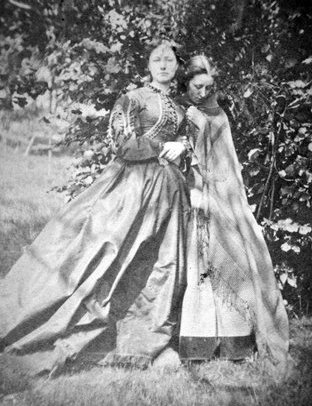
Jessie Edwards: Gathering Blackberries
Jessie Edwards: The Flower Garden
Mary Ellen Edwards ('MEE')
Mary Ellen Edwards, the daughter of Mary Johnson and Downes Edwards and the niece of Edward Killingworth Johnson, inherited the Meadows gift for art. She was born on November 6th 1838 on her father’s farm in Surbiton, and her early years were spent with her family in Surbiton, the Isle of Man, South Kensington, and Chelsea.
Training as an artist
Aspiring artists in mid-19th century London did not lack inspiration or talent, but their chances of developing their skills were apparently limited by ‘the guardians of the temple’ the artist-members of the Royal Academy. In a damning report in the ‘Royal Academy Review’ of 1860, the authors wrote: “ [The Royal Academy] occupies a false and an anomalous position in relation to English art … It’s teachings are disregarded, its schools deserted; because its professors repudiate in the exhibitions the principles they inculcate in the schools, and actually punish those who practise the precepts learnt in the Academy; … Because of the inability of the majority of the Royal Academicians to render valuable instruction; for when a student who has the inclination and talent for an historical painter, has frequently to receive tuition from a professor who is wholly incompetent to delineate the human figure, and who really has no artistic knowledge or ability … Hence we have private art academies and student societies, as Carey’s and Lee’s schools, the Kensington and Langham Chambers societies, and the South Kensington Government School, which are regularly and numerously attended.” Mary Ellen Edward’s formal training and experience in London at the end of the 1850s very much reflected the situation described by the authors of the Royal Academy Review.
At first Mary Ellen studied in Harley Street under the tutelage of the Royal Academician and historical painter, Edward Armitage, not far from Langham Place where her uncle Edward Johnson was also developing his style. Mary Ellen later moved on to the South Kensington School of Art, but apparently this was also a short-lived experience, and her training was apparently completed by “joining a group of friends to improve her technique”. Once again, it is not unlikely that this group may have included family members such as her sister Kate, who also trained as an artist, her uncle Edward Johnson and his friends from Langham Place (with whom she was later associated), and maybe a Meadows cousin or two. No doubt she would also have benefited as a child from the encouragement and advice of her great-uncles, John Massey Wright and James Meadows. During this early period, Mary Ellen alsow worked as a copyist at the National Gallery in London.
Creating a Sensation: illustrating in the 1860s
In the census of 1861, the twenty-three year old Mary Ellen Edwards was confident enough in her abilities and career prospects to state her profession as an artist, living at her parents’ home at 17, Brompton Crescent, South Kensington. Mary Ellen’s first exhibits at the Royal Academy, “I wandered by the brook side”, and “Idles Hours”, were shown in 1862, and these were the first examples by an artist who became a regular exhibitor at the Academy until 1908. From 1864 until 1866, Mary Ellen gave her address as 16 Oakley Street in fashionable Chelsea, one of a number of addresses in Kensington and Chelsea at which she lived from 1861 until 1872.
Mary Ellen’s career as one of the 19th century’s most prolific and successful female illustrators began in 1863 when Mary Ellen with illustrations for three different magazines concurrently during the 1860s: ‘London Society’ where she joined her uncle Edward Johnson and her sister Kate on the staff of illustrators; ‘The Churchman’s Magazine’, also illustrated by her uncle Edward in the same year; and ‘Belgravia’. The Bookseller for December 10th, 1863, noted with approval her illustrations for 'London Society', and reproduced the early illustration below, engraved by Horace Harral, a close friend of both her uncle Edward and her Johnson aunts. According to The Bookseller, Mary Ellen was, “an artist of great promise … We understand that Miss Edwards has been chosen by the proprietors to illustrate the new novel which is to appear in the January number of the magazine, and run through the volume for the year. This novel is by the author of ‘The Morals of May Fair’ [Mrs Annie Edwards, a prolific author and no relation of MEE], and its very suggestive title is ‘The Ordeal for Wives’.” The following year, 'The Bookseller' wrote approvingly once again of the Edwards-Harral combination in 'London Society', "This clever picture [illustrating the story, 'How the Goldsworthy Brothers spent Christmas Day'] is engraved by Harral from a drawing by Miss M.E.Edwards, a young lady who is gradually making for herself a reputation as an artist on wood."
Illustration for 'London Society', 1863
The ‘Belgravia’ was owned by the author Mary Elizabeth Bradon, and it was mainly devoted to the serialisation of her own popular ‘Sensation’ novels. In 1863 Mary Ellen provided the original illustrations in ‘Belgravia’ for ‘Aurora Floyd’ by M.E.Bradon, and in 1866 and 1867 she co-illustrated another Bradon sensation novel, ‘Birds of Prey’, including amongst other illustrators her uncle Edward’s friend, Charles Keene. Mary Ellen also became associated from 1866 and into the 1870s with another similar magazine, ‘The Argosy’, owned by the author Mrs Henry Wood. This magazine also offered its owner the opportunity to publish her own serialised novels, with illustrations by Mary Ellen.
If Mary Ellen owed her initial success as a magazine illustrator to her association with a renowned Victorian female author, her talent had not gone unnoticed by one of the most renowned and prolific Victorian male authors, Anthony Trollope. Like his contemporaries Charles Dickens or Wilkie Collins, Trollope’s novels were originally serialised in the popular literary magazines of the day. There is a suggestion that Mary Ellen may have illustrated Trollope’s story, ‘Can you forgive her?, published in 1863-64, but that at the time she used a pseudonym. But it was in December 1865, that Trollope’s publisher persuaded the author to entrust the illustrations for this next novel, ‘The Claverings’, to Mary Ellen Edwards. Trollope’s biographer recounts:
“Arrangements for the illustrations were made at the last minute: Smith knew of a twenty six year old artist, Mary Ellen Edwards, of whom he thought highly, and as late as 21st December 1865, Trollope wrote to him to suggest the subjects for both the vignette at the opening of the novel and the full-page illustration for the first instalment; he designated also what should be the legend under the picture, for which he ordinarily preferred a quotation from his text. It may be supposed that the remaining fifteen illustrations and vignettes were similarly chosen by him. “M.E.E.” had a long career as an illustrator, and her drawings for ‘The Claverings’ were at least satisfactory, and sometimes more than that. The work was published in two volumes, with full page illustrations but not the vignettes, about April 20th, 1867.” (Extract from ‘The Chronicler of Barsetshire’ by R. H. Super). The link below allows you to view the illustrations for the first page of the first chapter of ‘The Claverings’, published in February 1866.
IIlustrations for The Claverings
In 1866, Mary Ellen also illustrated a second serialised novel by Charles Lever for ‘London Society’, entitled ‘The Bramleighs of Bishop’s Folly’. Illustrating for the magazines on the cutting edge of the Victorian literary world did not, however, stop Mary Ellen from acquiring other commissions. In 1864, she also began to illustrate the semi-religious magazine, ‘Golden Hours’; ‘The Sunday Magazine’ from 1865; and in 1866 she also began illustrating ‘Good Words’ (notably the serialised novel, ‘Ruth Thornby’), ‘Aunt Judy’s Magazine’ (publishing the popular children’s’ stories of Mrs Gatty), and ‘The Quiver’. In 1867, Mary Ellen was responsible once again for the illustrations of the new serialised novel in ‘London Society’, ‘That boy of Northcott’s’ by the popular Irish author Charles Lever, as well as contributing to Cassell’s Magazine (where she collaborated with H.D.Linton, the younger brother of her uncle’s mentor W.J.Linton), and The Illustrated Times. By 1868, she was also contributing to another magazine, The Broadway, which quoted ‘The Hastings Herald’ in its publicity campaign as saying, “There are some capitally executed illustrations from the pencils of G.H.Thomas, M.E.Edwards, etc.”
Illustration for 'The Quiver', 1868
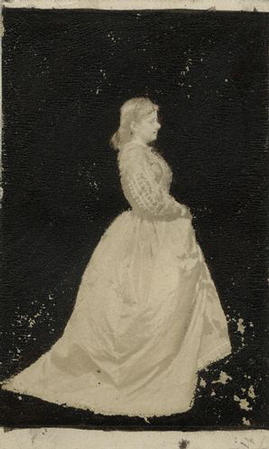
(Above) Portrait of Mary Ellen Edwards in the 1860s, by an unknown photographer. © National Portrait Gallery, London. Reproduced by permission.
(Below) Mary Ellen's dedication of a gift to a friend. (Reproduced from a private family collection, by kind permission of the owner.)

Mary Ellen’s activities in the 1860s were not simply confined to magazine illustration. In 1864 she contributed to the illustration of a commemorative tome to mark the 300th anniversary of Shakespeare’s birth, an author whose representation she no doubt knew well from her great uncle John Massey Wright’s abundant works; and she also published her first children’s illustrations in ‘The family fairy tales, or glimpses of elfland from Heatherston Hall’. The following year she was also asked to contribute illustrations for ‘Divine and Moral Sings’, together with Holman Hunt and George Du Maurier (another friend of her uncle Edward), and also to ‘Legends and Lyrics’ which was illustrated by the three friends Mary Ellen Edwards, Charles Keene and Horace Harral. In 1867, in the same year that ‘The Claverings’ appeared in book form with her illustrations, she was called upon (along with Edward Burne-Jones and G.H.Thomas) for Mrs Gatty’s, ‘Parables from Nature’, and for ‘Idyllic Pictures’, a collection of illustrations by some of the leading artists of the day, including G.H.Thomas once again.
What is clear throughout this period is that Mary Ellen was quickly recognised as a talent in her own right, to be considered on a par with her uncle Edward Killingworth Johnson, and his friends Charles Keene, Horace Harral and George Du Maurier with whom she often collaborated, but also with other artists such as Edward Burne-Jones, Walter Crane, Holman Hunt, and George Housman Thomas, one of the favourite artists of Queen Victoria who painted many of the principal royal events of the period. Thomas was an illustrator of international renown, who had illustrated the original editions of ‘Hiawatha’ for Longfellow, and ‘Uncle Tom’s Cabin’, as well as ‘The Last Chronicles of Barsetshire’ by Trollope and ‘Armandale’ by Wilkie Collins. He was also for a time a contributor to The Illustrated London News, and so was yet another contemporary and friend of Mary Ellen’s uncle, Edward K.Johnson. Thomas’ influence on Mary Ellen’s work was noted as early as 1865, when one critic noted that her illustrations of the story ‘Grandfather’s Sunday’ for The Sunday Magazine, were “under the influence of G.H.Thomas”.
By 1866, Mary Ellen’s father had moved his family from South Kensington to South Parade in Chelsea, close by St Luke’s Church. It was here that Mary Ellen made her first marriage, on June 13th 1866 at St Luke’s, Chelsea, to John Freer, who was twelve years older than Mary Ellen, and worked for the P&O Line. The fashionable young couple returned to South Kensington, and on November 3rd, 1867, their son John Edwards Leslie Freer was born at the family home at 23, Pelham Place. However their happiness was to be short-lived, as Mary Ellen’s husband died suddenly in 1869, leaving the successful young artist a widow and single mother at the age of thirty.
Sible Hedingham, a second marriage, and a second sadness.
When the 1871 census was taken, Mary Ellen and her son John were visiting Aunt Fanny Johnson at Bakers’ Farm in Sible Hedingham, where Mary Ellen’s cousins Fanny and Floramel Philpott were also living. Later in the same year, Edward Killingworth Johnson married and moved back to Baker's Farm. In the late 1860s and the 1870s, Mary Ellen's exhibits in the annual Royal Academy shows was the subject of regular note by the critics of the 'Art Journal', but whilst they admired her skill and composition, they also displayed a certain ennui at her choice of her subjects. In 1867, the Journal commented, "Mary Ellen Edward's 'Evening' is too much like last year's submission, but is still commendable in the care in which it is done", although the Fine Arts Quarterly Review disagreed, noting that " 'Evening' by Miss M.E.Edwards has a refined beauty like 'The Kiss' of the previous year". Nonetheless Mary Ellen's 1873 entry drew a similar comment as before from 'The Art Journal' for 'Sweet Success', noted for "the skill in handling of colour and light", even though, "the subject is not really the best". Finally in 1875 'The Art Journal' approved Mary Ellen's entry, "a clever picture of two tree-carving lovers entitled, 'The Record'." Significantly, by this date, Mary Ellen was no longer exhibiting her work under the name of Edwards of Freer, but of that resulting from her second marriage.
The Royal Academy records for 1871 record Mary Ellen’s own home address as 10 Gloucester Road, Hereford Square, in South Kensington. In the 1871 census, one of the residents at the same address was another artist and illustrator, John Charles Staples. In 1872, Mary Ellen followed her uncle’s example, and Mary Ellen Freer became Mary Ellen Staples following a wedding in Kensington. In 1873, however, Mary Ellen decided to follow her Uncle Edward’s example once again, and she left London with her family for Essex. But with Edward and Hannah Johnson already living at the farm with Aunt Fanny, Mary Ellen and John C.Staples moved to The White House in the village of Sible Hedingham from 1873 until 1876. From this point onwards, the relationship between Mary Ellen and her Uncle Edward developed from an already close family circle, to an increasing level of personal and professional intertwinement.
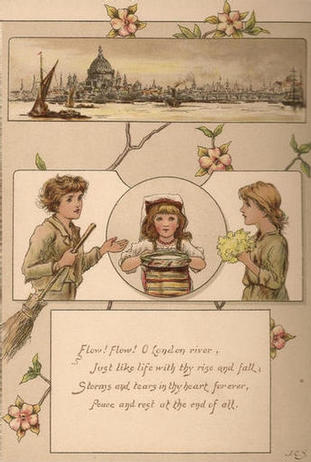
Illustrations by John Staples for Frederick Weatherly's anthology of childrens poetry, 'Told in the Twighlight'.

John Staples specialised in illustrations for children’s books, and Mary Ellen naturally expanded her artistic repertoire to encompass her husband’s speciality, and to allow the couple to work together. However this did not stop Mary Ellen from pursuing her own flourishing career as a newspaper and magazine illustrator, which ensured the financial stability of the household. The historian Deborah Cherry describes the background to this period in her book, ‘Painting Women’:
“Women artists participated in the growing reprographic markets, augmenting their incomes from the sales of oil paintings or watercolours and their reputations as artists by designing illustrations for magazine and book publishers. A few, such as Helen Allingham, Mary Ellen Edwards, and Florence Caxton, were salaried members of staff or regular contributors to illustrated papers. Unlike their male contemporaries … women were commissioned for vignettes of middle-class social and domestic life. In addition papers such as ‘The Graphic’ and ‘The Illustrated London News’ purchased individual exhibited paintings for reproduction as featured illustrations as well as commissioning series … Regular work as commercial artists, direct orders from clients, and a relationship with a dealer, helped women artists to counteract the fluctuations of the art market which were aggravated by the recession from the late 1870s to the 1890s.”

Mary Ellen's illustration of Frederick Weatherley's poem, 'Toby's lesson': "A was the Alphabet Toby must say, B was the Birch that made him obey ..."
The foundation of 'The Graphic' in 1869 caused more than a stir in the closed world of Victorian engravers. The magazine was founded as a rival to the 'Illustrated London News', and one of its aims was to encourage social reform. Amongst the founders of 'The Graphic' was William Luson Thomas, the brother of G.H.Thomas, and Henry Sutherland Edwards, who was closely connected to the failed 'Illustrated Times', for which Mary Ellen had provided illustrations in 1867. Like Mary Ellen's uncle Edward Killingworth Johnson, Luson Thomas was a former apprentice to W.J.Linton whose firm engraved for the 'Illustrated London News'. Luson Thomas had already collaborated with Mary Ellen Edwards in 1864 to illustrate the Shakespeare memorial volume, and again at 'London Society' in 1867. Illustrators were free to work for rival magazines if they were commissioned, and Mary Ellen became an illustrator for ‘The Graphic’ from the outset, and she was joined here once again by her uncle Edward Johnson. Both Edward and Mary Ellen continued to contribute to 'The Graphic' and ‘The Illustrated London News’ almost simultaneously, and Mary Ellen was commissioned to produce the front cover of the Christmas edition of the 'Illustrated London News' in 1878. However it was Mary Ellen's illustrations for 'The Graphic' which proved to have the widest audience and influence, including the up-and-coming French artist, Vincent Van Gogh. He was highly interested in the Engish illustrated periodicals of the period, and he noted and commented on Mary Ellen's work in several of his surviving letters.
Distance from London does not appear to have hindered the careers of either artists, and Mary Ellen also continued to contribute illustrations for ‘Belgravia’ in 1876 (in the decade when the magazine published the works of Wilkie Collins and Mark Twain), and for 'The Argosy', as well as illustrating at least four books between 1873 -1879. These included a first volume of the collected works of Mrs Bradon, a new edition of Grace Aguilar's, 'Home influence; a tale for mothers and daughters'; and an edition of Grimm’s Tales in 1879. In the 1870s and 1880s, Mary Ellen Edwards also collaborated once again with William Luson Thomas, but also with another 'Illustrated London News'engraver, John Greenaway, and his daughter Kate, to illustrate the children's stories of Emma Lewis Sandford.
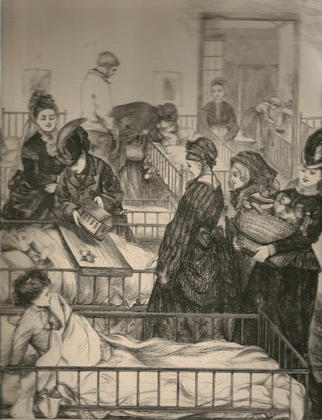
Mary Ellen Edwards illustrations for 'The Graphic': (above)'Children's Hospital', an illustration by Mary Ellen Edwards from 'The Graphic', December 1869 (below) 'A swimming lesson at Brighton', September 1871
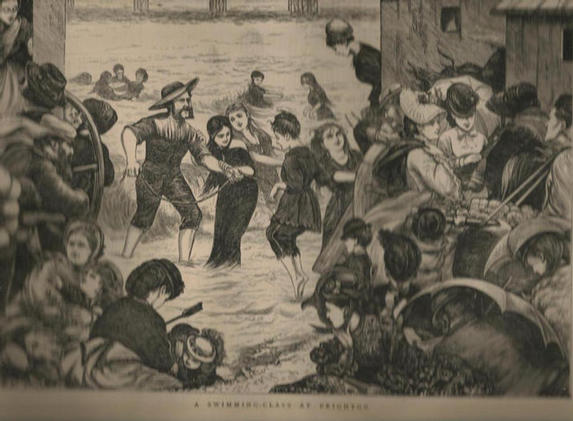
Front cover of The Illustrated London News, Christmas 1878
After leaving Sible Hedingham in 1876, Mary Ellen appears to have led a charmed existence, at least on paper, living in the Isle of Wight in 1877, then once again in Chelsea in 1879, before moving to Brighton for the first time in 1880 to be close to her family. By the time of the 1881 census, Mary Ellen and John were living in Hove, close to the Edwards family, with John Freer (Mary Ellen’s son from her first marriage), and were being visited by uncle Edward Johnson; three artists together under the same roof. However if Mary Ellen’s South Coast sojourn sounds idyllic, life in and around Brighton was more than tinged with sadness, with the successive deaths there of her father in 1881, her eldest brother in 1885, and Mary Ellen’s own son John Freer in 1886, aged only eighteen.

Mary Ellen's illustration of Frederick Weatherley's poem, "Sorrows", published in 'Holly Boughs' and 'Told in the Twighlight'.
The 1880s and 1890s: illustrating the works of Frederick Weatherly and editing 'Atalanta'
For the first fifteen years of her career, Mary Ellen concentrated principally upon illustrating adult fiction and journals.During this period Mary Ellen began illustrating children's books, including for the favourite author of the genre of the 1860s, Mrs Gatty. But the last thirty years of her career were mainly dedicated to children's illustrations, and some adult book fiction. From 1880 until the early 1890s, the careers of both John Staples and Mary Ellen Edwards developed principally, but not exclusively, by the illustration of childrens books by the author Frederick Edward Weatherly (1848-1929), working for the publishers Hildesheim & Faulkner.
Weatherly trained and practised as a barrister (the same profession as Mary Ellen's brother, William Edwards), and even became a King's Counsel, but his reputation reposes on his career as an author, song-writer and later a radio performer. He was a profilific song-writer, and amongst his best-known compositions are 'The Holy City', 'Danny Boy' which he wrote in 1909 and set to the Londonderry Air in 1912, and the World War One ballad, 'Roses of Picardy'.
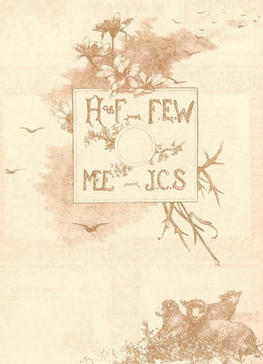
A winning combination: this logo, probably designed by John Staples, appeared in 'Holly Boughs'. It represents the publishers Hildesheim & Faulkner, the author Frederick E.Weatherly, and the illustrators Mary Ellen Edwards and John Charles Staples.
Weatherly wrote adult fantasy fiction, but also numerous childrens books. The first signed illustrations by Beatrix Potter appeared in one of Weatherly's books for children. The first books illustrated by John Staples and Mary Ellen Edwards for F.E.Weatherly was the appropriately named, 'Throught the Meadows' in 1880, which includes some of Mary Ellen's finest illustrations, including the examples below. Other examples of Weatherly's work illustrated by the couple include 'The Illustrated Childrens Birthday Book'(1882) co-illustrated with Kate Greenaway, 'Holly Boughs' and 'Little Pussy Cat', both of which were compiled in 'Told in the Twighlight' (1883), 'Twighlightland' (1884),'The adventures of two children (1884), 'Twighlight Tales' (1890),and 'The Star of Bethlehem'. Mary Ellen's uncle, Edward Killingworth Johnson, also illustrated two of Weatherly's books, 'Sunbeams', published c.1888, and 'Sunlight and Song', published in 1892.
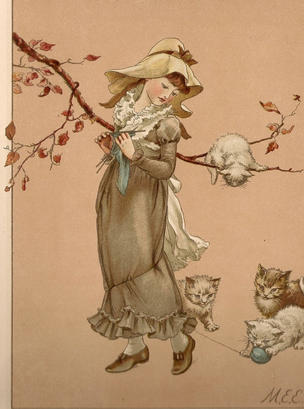


The New York Times review of November 20th, 1883 for 'Told in the Twighlight' noted: "The full-page drawings and borders of this pretty book are fair examples of draughtsmanship, but the great feature is the delicate blending of many colours in the oil paints. It belongs to the best class of English work for children's books. The illustrations are by M.Ellen Edwards and John C.Staples. English landscapes, village views, and rustic children accompany the verses, which are supposed to be told to the little ones at twighlight."

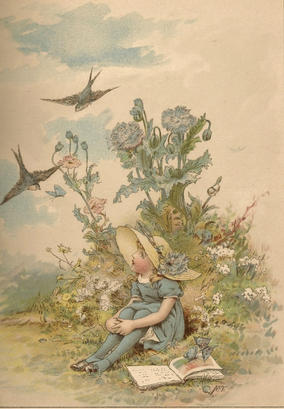
"Village views, and rustic children": illustrations for 'Told in the Twighlight' by Mary Ellen Edwards (above) and John C.Staples (below).
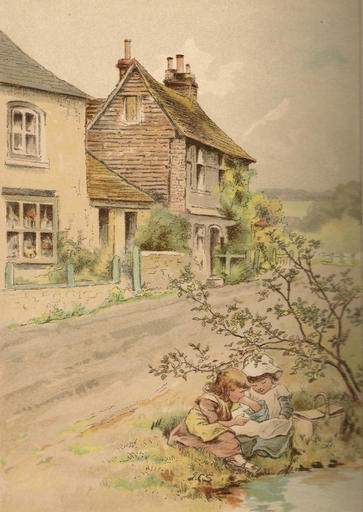
The Johnson-Edwards-Staples connection with Hildesheim & Falukner did not stop at book illustration. Like their rivals, the publishers were also printers of Christmas cards, and Mary Ellen and her uncle Edward were regular and successful designers for this new popular seasonal art. In 1883, Hildesheim & Faulkner went so far as to launch a competition, announced in 'The Artist' magazine, with prizes worth £1000, for the most artistically-presented albums of Christmas cards. The panel of judges included Mary Ellen, a fellow illustrator and designer Alice Havers, and Mrs William Duffield, the noted flower artist. Mary Ellen's own contributions to her publisher's festive publications also included their Christmas Books in 1882 and 1883.
Despite this flourshing relationship, Mary Ellen did not illustrate exclusively for Hildesheim & Faulkner during this period. She collaborated with Kate Greenaway, amongst others, to illustrate 'The Grey Girls', by E.Haile, in 1880, and 'Little Castles with Big Wings' by George Kringle in 1881. Amongst her other numerous book illustrations from this period were those for 'Little Red Riding Hood' by W.Gunston, and 'Little Tiny's Book of Objects' published by Routledge with more than seven hundred illustrations, both published in 1881; and Fairy Tales and Sketches by Hans Christian Andersen in 1887.
The authors of adult fiction for whom Mary Ellen illustrated in the 1880s and 1890s represent an eclectic mix of the competing themes of the late 19th century. Thomas Wilkinson Speight's, 'The Mysteries of Heron's Dyke' (1883) was a classic Victorian novel. But a new generation of women authors (or more correctly, their publishers) were calling upon Mary Ellen's talents to illustrate their varied tales, of Evangelical piety for Mrs Walton ('Taken or left'in 1885, and 'Nobody loves me' in 1902); the novel of the travel writer Matilda Charlotte Houston ('The Heir of Elmdale' in 1888); an early novel by the first woman journalist, Flora Louisa Shaw ('A sea change' in 1886); or a novel ('Her object in life') in 1884 by the suffragette and anti-lynching campaigner Isabelle Fyvie Mayo, who wrote for 'The Argosy', 'The Quiver' and 'The Girls Own Paper' and who began her career at the Office for the Employment of Women in Langham Place in the 1860s when Mary Ellen and her uncle were sketching there.
However another new development of the period with which Mary Ellen and her husband were heavily involved and identified, was the explosion of both books and magazines for 'the forgotten readers', adolescent girls for whom children's books were too young, and adult fiction was not yet suitable. Two names came to dominate this market, and both were close friends and collaborators of Mary Ellen and John Staples: Mrs Meade and Mrs Molesworth.
Mrs Meade (1854-1914) and Mrs Molesworth (1839-1921) were the two undisputed doyennes of the new market of adolescent girls' fiction. Although they were literary rivals, with differing view aims as to the role of women in society, they nonetheless worked together and found points of common interest, one of which was Mary Ellen Edwards. Her association with the authors began with Mrs Molesworth in 1880, for whom Mary Ellen illustrated 'Hermy, the story of a girl', before going on to illustrate some of Molesworth's classic tales of adolescent girls such as 'The Boys and I' (1883), or 'Bashful Fifteen' (1893). It did not take Mrs Meade long to call upon the services of Mary Ellen also to illustrate her own novels, 'A world of girls: the story of a school' (1886), 'Deb and the Duchess' (1888), and the tellingly-named, 'Polly, a new fashioned girl'(1889), in the same year that Mary Ellen also illustrated three novels for Mrs Molesworth. Meade and Molesworth had differing objectives in their literature - the former was a feminist, the latter a firm believer in family values and the virtue of motherhood - but they shared not only a common market, but also a common access to that market in the magazine 'Atalanta', formerly 'Every Girl's Annual'. Meade was the co-editor of 'Atalanta', and from 1888-1891, John C.Staples shared the editorship with her. Staples was already known to his new readers as the author of an article on how to paint in oil colours, for 'The Girl's Own Indoor Book' of 1888, published by Charles Peters of the rival 'Girl's Own Paper', and Staples once again illustrated the Indoor Book in 1892 when he was no longer editor of 'Atalanta'.
'Atalanta' began with a range of high-brow literary contributors, but by the time that Staples became co-editor, the contributors were less well-known, at the time. Staples is credited with a series of unsigned articles on art, including an article on 'Mr Ruskin's view' (who, by coincidence, was busy at the time destabilising Kate Greenaway), 'Outlines of a course of study for art', and 'Women in contemporary art', for which he did not have to search very far for his subject material, as he chose to write about Alice Havers, who presided the Christmas Card jury with Mary Ellen Edwards in 1883. During this period, Molesworth's stories appeared regularly in the paper, as well as Mary Ellen's illustrations and others by her uncle Edward K.Johnson, and Ernest Wilson, who collaborated with Edward Johnson to illustrate Weatherly's books and also designed Christmas cards. Unsurprisingly Weatherley's books gained favourable recommandations, but rather more surprisingly, the winner of 'The Atalanta Fine Art Scholarship' in 1890, for a "stunning result", was Miss Barbara Johnson (Mary Ellen's cousin!), aged 14, for a painting named 'Charity'. Another regular contributor at this time, reflecting Mrs Meade's mores rather than those of Mrs Molesworth, was the personally unconventional but successful new children's writer, Edith Nesbit, who married her husband when seven months pregnant, raised her husband's illegitimate children, was a founder member of the Fabian Society, and also found time to write 'The Railway Children' amongst her other numerous novels.
It would be tempting to see Mary Ellen Edwards as one of the rising generation of female suffragists through her association and work in this period. In many senses she would make an ideal suspect, as a successful independent woman who had made her own career. But it would be foolish to overlook the fact that her art was also her commodity, which meant that she was as willing to illustrate the works of the homely Mrs Walton as the more strident Mrs Meade or Mrs Mayo. As an example of this, Mary Ellen illustrated 'Every Boy's Annual' for Routledge in 1886, in the same year that she illustrated for Meade and Mayo. Moreover, the evidence that Mary Ellen may have shared more of Mrs Molesworth's preoccupations with maternity and family life at this period were strong, despite the loss of her own son.

An illustration by Mary Ellen Edwards for 'The Story of a Spring Morning', by Mrs Molesworth, 1890.
Surrey and later London life
At the time of the 1891 census, the Staples were living at Park Lands, on Dick’s Hill, in the picturesque village of Shere near Guildford. A very notable addition to their household at this time was their adopted daughter Faith Strong, born in Ireland c.1883. Precisely when the Staples chose to adopt Faith, and how they came to choose her, is not known. But Mary Ellen had made a very conscious choice of renewed motherhood at nigh on her fiftieth birthday, at the height of her career.
By the end of the century, Mary’s family circle was decreasing. Her uncle Edward died in 1896, her father had died in 1882 and her eldest brother in 1885, and John Staples had also died by the end of the century. When the first census of the new century was taken, Mary Ellen was living with her daughter Faith in Lancaster Road in London, along with elderly Aunt Fanny Johnson whom she had no doubt ‘inherited’ on the death of her uncle. In 1907, Faith married, and by 1911, Mary Ellen was living alone for the first time in her life, save for two servants, at 88, Abbey Road in Hampstead, only a few streets from where her uncle Edward had lived out his final years in Compayne Gardens.
Mary Ellen continued to exhibit her work until 1908. However after more than forty years of public exposure, and with changing fashions, her Victorian heroines had become over-romanticised for her admirers, and boring and monotonous for her detractors. Nonetheless, she is considered one of the foremost female illustrators of her day.
Mary Ellen died on 22nd December, 1934, at the home she shared with her surviving sibling, Downes Ernest Edwards, at Hillcroft Cottage in Hillcroft Crescent, Ealing, in her 96th year. Until the very last she was identified with her artistic persona, and the notice of her death in The Times included her famous signature, MEE.

Mary Ellen's illustration of Frederick Weatherley's poem, 'Bell's Dream', from 'Little Pussy Cat' and 'Told in the Twighlight'
Mary Ellen Edwards on the web
Unless otherwise stated, the illustrations above by Mary Ellen Edwards and John C.Staples are reproduced from a private family collection, by kind permission of the owner.
The first two links below will take you to Mary Ellen's illustrations for 'The Claverings'. In the first link select 'show illustrations' to visualise the images.
Selected illustrations from 'The Claverings'
A detailed illustrated list of illustrations for 'The Claverings'
The following sources, available on Google Books, provide information on the career of Mary Ellen Edwards: 'English Illustration; The Sixties, 1855-1870', by Gleeson White, published in 1897; ‘The Letters of Anthony Trollope’, edited by N.John Hall & Nina Burgis, Stanford University press, 1983; ‘The Chronicler of Barsetshire’, by R.H.Super, University of Michigan Press, 1991; ‘Charles Dickens and his original illustrators’, by Jane R.Cohen, Ohio State University Press, 1980; ‘Painting women: Victorian Women Artists’, by Deborah Cherry, Routledge, 1993; ‘A Gallery of her own: an annotated bibliography of women in Victorian painting’, by Elree I.Harris and Shirley R.Scott, Taylor & Francis, 1997.
The links below also provides useful information on Mary Ellen Edwards and her contemporary female illustrators. The first link is to an excellent article on Mary Ellen's life and work from the renowned 'Victorian Web' site.
Mary Ellen Edwards the illustrator
19th century women painters and illustrators
|